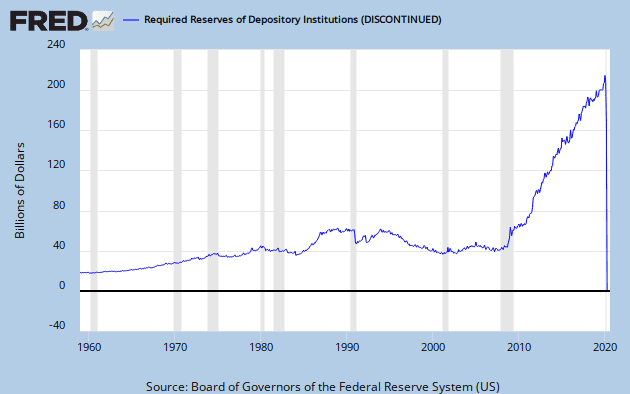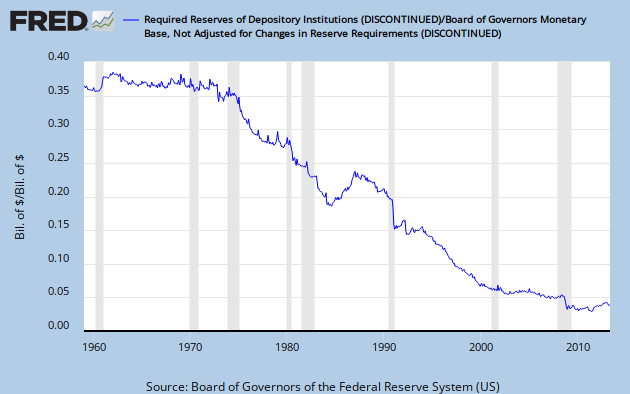Widdekind
Member
- Mar 26, 2012
- 813
- 35
- 16
"toy model" of fractional-reserve banking
"inside" -- how much money remains "reserved" in banks ?
"outside" -- how much money remains "un-saved" in circulation ?
"reality check"
Fractional-reserve banking "fabricates" no new money; the total fractional amount remaining, both in circulation, and reserved in banks, becomes:
Fractional-reserve banking reduces "hoarding"
without banks, the ratio, of money still in circulation, to money reserved in banks, would be
S = "Savings" rate (into banks)
S* = (1-S) = "not Saved" rate
F = "Fractional-reserve" requirement (used by banks)
F* = (1-F) = "not reserved" rate
S* = (1-S) = "not Saved" rate
F = "Fractional-reserve" requirement (used by banks)
F* = (1-F) = "not reserved" rate
"inside" -- how much money remains "reserved" in banks ?
S* not saved, S saved...
of S, SF* not reserved (loaned back out), SF reserved
of SF*, SF*S* not saved, SF*S saved...
of SF*S, SF*SF* not reserved (loaned back out), SF*SF reserved
of SF*SF*, SF*SF*S* not saved, SF*SF*S saved...
of SF*SF*S, SF*SF*SF* not reserved (loaned back out), SF*SF*SF reserved
by extrapolation, after an infinite sequence, of "savings; re-lendings & re-savings", the final fraction remaining reserved, in banks, becomesof S, SF* not reserved (loaned back out), SF reserved
of SF*, SF*S* not saved, SF*S saved...
of SF*S, SF*SF* not reserved (loaned back out), SF*SF reserved
of SF*SF*, SF*SF*S* not saved, SF*SF*S saved...
of SF*SF*S, SF*SF*SF* not reserved (loaned back out), SF*SF*SF reserved
= SF + SF(SF*) + SF(SF*)^2 + ...
= SF [ 1 + (SF*) + (SF*)^2 + ... ]
= SF / [1 - (SF*)]
= SF [ 1 + (SF*) + (SF*)^2 + ... ]
= SF / [1 - (SF*)]
"outside" -- how much money remains "un-saved" in circulation ?
S* not saved, S saved...
of S, SF* not reserved (loaned back out), SF reserved
of SF*, SF*S* not saved, SF*S saved...
of SF*S, SF*SF* not reserved (loaned back out), SF*SF reserved
of SF*SF*, SF*SF*S* not saved, SF*SF*S saved...
by extrapolation, after an infinite sequence, of "savings; re-lendings & re-savings", the final fraction remaining un-saved, in circulation, becomesof S, SF* not reserved (loaned back out), SF reserved
of SF*, SF*S* not saved, SF*S saved...
of SF*S, SF*SF* not reserved (loaned back out), SF*SF reserved
of SF*SF*, SF*SF*S* not saved, SF*SF*S saved...
= S* + S*(SF*) + S*(SF*)^2 + ...
= S* [ 1 + (SF*) + (SF*)^2 + ... ]
= S* / [1 - (SF*)]
= S* [ 1 + (SF*) + (SF*)^2 + ... ]
= S* / [1 - (SF*)]
"reality check"
Fractional-reserve banking "fabricates" no new money; the total fractional amount remaining, both in circulation, and reserved in banks, becomes:
= SF / (1 - SF*) + S* / (1 - SF*)
= (SF + S*) / (1 - SF*)
= (SF + [1-S]) / (1 - S[1-F])
= (1-S+SF) / (1-S+SF)
= 1
= (SF + S*) / (1 - SF*)
= (SF + [1-S]) / (1 - S[1-F])
= (1-S+SF) / (1-S+SF)
= 1
Fractional-reserve banking reduces "hoarding"
without banks, the ratio, of money still in circulation, to money reserved in banks, would be
S* : S
with banks, using Fractional-reserves, the ratio increases, to:S* : SF
for example, if S = F = 0.1, then Fractional-reserves reduces "hoarding", from ~10%, to ~1%. Ipso facto, Fractional-reserve banking:- does not "fabricate" Money
- does reduce "hoarding", i.e. "accelerates" otherwise-zero-velocity Money ("that's how bankers make their Money")


